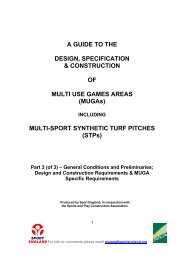View - North East Lincolnshire Council
View - North East Lincolnshire Council
View - North East Lincolnshire Council
You also want an ePaper? Increase the reach of your titles
YUMPU automatically turns print PDFs into web optimized ePapers that Google loves.
BOC Immingham Dissolved Acetylene Project Environmental Statement: Vol. 2 Main Text<br />
BS 7445: Description and Measurement of Environmental Noise, Parts 1 to 3, 2003<br />
11.28 BS 7445: 2003 provides detailed information on environmental noise measurement procedures<br />
and the reporting of environmental noise levels. Guidance is given on how to measure and assess<br />
noises with a tonal component. It also provides specific information on suitable weather conditions<br />
for noise measurements.<br />
Road Traffic Noise<br />
11.29 The impacts of road traffic noise generated during the construction and the operation of the<br />
development on the existing road network would be assessed in accordance with the methods in<br />
the DMRB which uses calculation procedures from the Department for Transport Memorandum<br />
Calculation of Road Traffic Noise 86 .<br />
11.30 The Calculation of Road Traffic Noise provides methods for measuring and calculating noise<br />
levels from road traffic, which are assessed over an 18 hour period from 06:00 to 24:00, using<br />
annual average weekday traffic (AAWT) flows. The basic noise level for a road segment can be<br />
calculated using the traffic flow, traffic speed and percentage heavy vehicles for a road segment.<br />
The traffic data will be based on the construction methods that are to be employed and<br />
information from the traffic assessment.<br />
11.31 The DMRB details the assessment methodology relating to noise and nuisance exposure. It<br />
provides guidance on the significance of changes in road traffic noise, identifying that changes in<br />
noise smaller than 1 dBA are not perceptible. An increase in traffic volume of 25% is required to<br />
alter the noise levels by 1 dBA.<br />
Assessment Criteria<br />
Construction Noise<br />
11.32 Construction noise impacts are temporary in nature and hence a higher level of noise impact is of<br />
lesser significance than would be the case for permanent noise changes.<br />
11.33 Example method 2 of BS 5228 sets out that noise levels generated by construction activities are<br />
deemed to be significant if the total noise (pre-construction ambient plus construction noise)<br />
exceeds the pre-construction ambient noise by 5 dB or more, (subject to the total noise threshold<br />
values of 65 dB, 55 dB and 45 dB LAeq,period for the daytime, evening and night-time periods<br />
respectively). These criteria are applicable to residential receptors and other community education<br />
health buildings.<br />
11.34 For a public open space, which is more akin to the nature of Humber Estuary, the significance<br />
criteria recommended by BS 5228 remain the same but with no lower cut-off values i.e. a<br />
significant effect is deemed to occur if the total noise exceeds pre-construction ambient noise by<br />
5 dB or more. There is no guidance as to the degree of significance of noise changes above this<br />
level.<br />
Operational Noise Impacts at Residential Receptors<br />
11.35 Noise limits due to the operation of the facility have been derived taking into account the<br />
recommendations provided by the NELC EHO and also the guidance provided in BS 4142.<br />
11.36 The EHO 85 has advised that a rating noise level that does not exceed the existing background<br />
noise level at the nearest residential receptors should be acceptable. In accordance with BS 4142,<br />
applying this criterion is therefore likely to result in a less than marginal significance with regard to<br />
the likelihood of complaints.<br />
5100935.404 Environmental Statement August 2011 192




